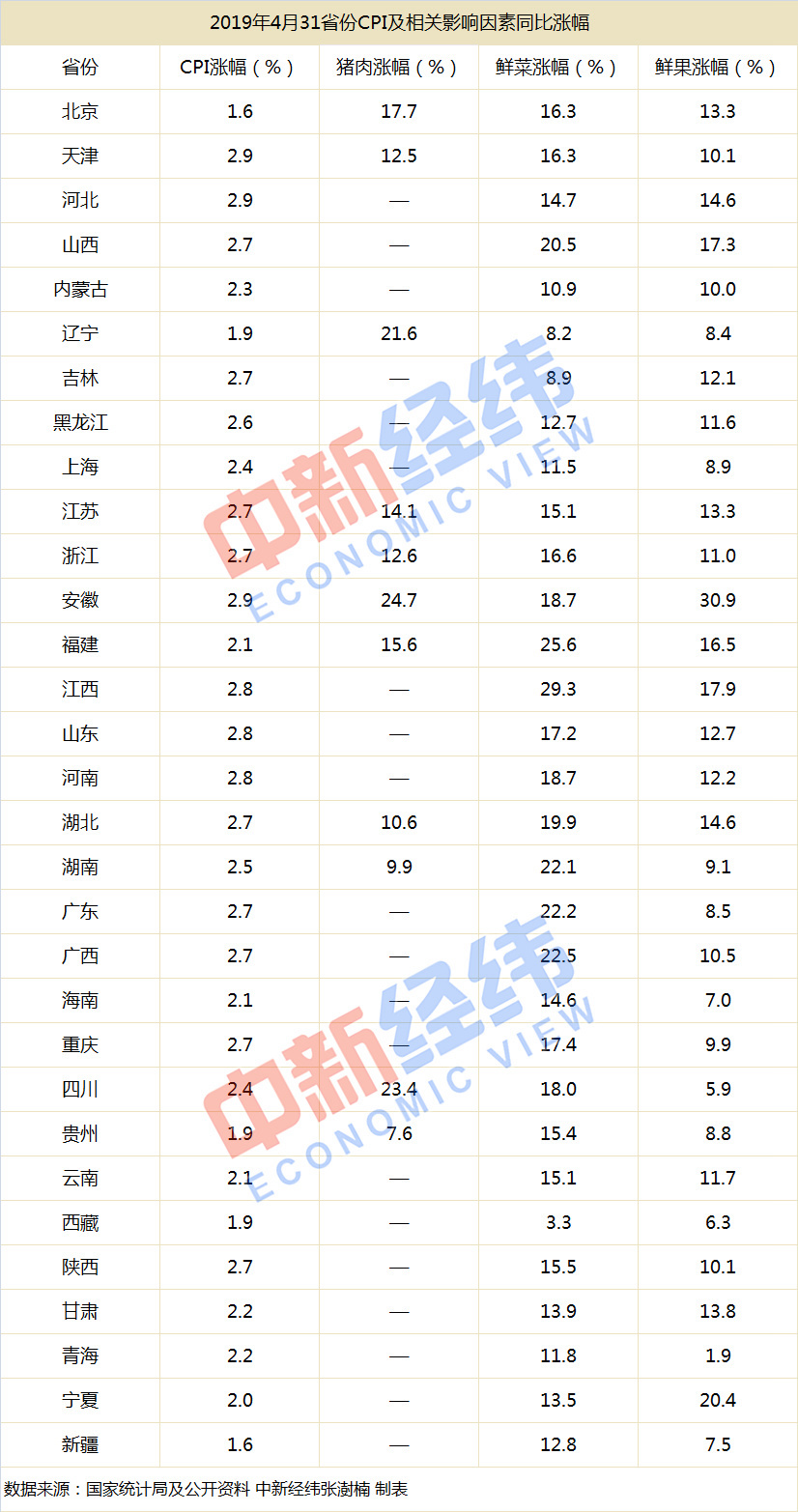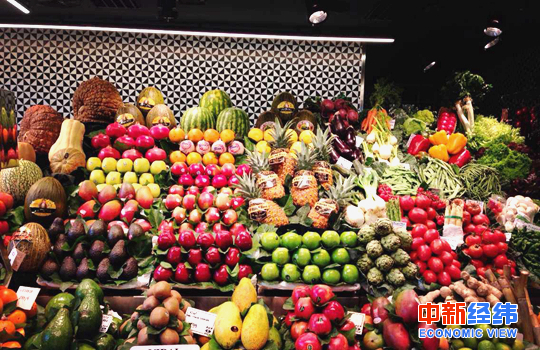In April, the CPI of 16 provinces rose by more than 30%, ranking first in Anhui fruit price increase.
Zhongxin Jingwei Client May 23rd (Zhang Yunan) CPI data of 31 provinces in April 2019 have been released one after another, and hot topics such as "Garlic You Bite", "Cherry Freedom" and "Toona sinensis Freedom" have recently returned to the public’s field of vision. Under the strong siege of vegetable prices and fruit prices, what are the CPI performances of the provinces?
CPI in 16 provinces rose more than the whole country.
In April 2019, the national consumer price rose by 2.5% year-on-year, continuing to be in the "2 era". In food, the price of fresh vegetables is still at a high level, rising by 17.4% year-on-year, affecting the CPI increase by about 0.43%; Pork prices rose by 14.4%, an increase of 9.3% over the previous month, which affected the CPI increase by about 0.31%. Last autumn, the fruit harvest in the north was poor, and this year’s stock was insufficient. The price of fresh fruit rose by 11.9%, which affected the CPI increase by about 0.22%.
From the perspective of 31 provinces in China, according to the incomplete statistics of Sino-Singapore Jingwei client, the CPI of 16 provinces rose more than the whole country in April, with the highest increase in Tianjin, Hebei and Anhui, reaching 2.9%; Hunan and the national CPI rose flat, up 2.5% year-on-year; The increase in Beijing and Xinjiang was small, at 1.6%.

Don’t look at the classification, there are 13 provinces with a year-on-year increase in fresh fruits over the whole country, and Anhui has an increase of 30.9%, the largest increase; Only the fresh fruit in Ningxia rose by more than 20%, which was 20.4%; There are 18 provinces with an increase of over 10%, with a large number; Qinghai rose by 1.9%, with a small range.
In addition, there are 10 provinces where the year-on-year increase of fresh vegetables exceeds the national level; Chongqing and the national fresh vegetables rose at the same level, at 17.4%; There are three provinces with an increase of less than 10%.
On pork, from the provinces that have announced the increase, Anhui has the largest increase, reaching 24.7%; Followed by Sichuan, up 23.4%; The lowest is Guizhou, up 7.6%.
Is it really so difficult to achieve "fruit freedom"?
Following "Toona sinensis Freedom", "Garlic You Are Malicious" and "Cherry Freedom", "Fruit Freedom" has also been screened on the Internet recently, which has aroused heated discussions. In fact, after the Spring Festival, the news about the price increase of fruits is endless. It is even reported that the fruit price in Beijing Xinfadi wholesale market has generally increased by 78% compared with the same period of last year.
The Zhongxin Jingwei client combed the website data of the Ministry of Agriculture and Rural Affairs and found that the price of Fuji apple has been rising for 9 weeks in a row among the five fruits it focuses on monitoring. As of mid-May, the price of Fuji apple was 10.33 yuan/kg, up 60.7% year-on-year. In addition, the price of watermelon has been on the rise year-on-year. As of mid-May, the price of watermelon was 4.86 yuan/kg, up 29.7% year-on-year.
It is worth noting that the retail price of fruit is also "rising". According to the data of Hunan Provincial Department of Commerce, from May 15th to 21st, the number of seasonal fruits on the market decreased, the purchase price of producing areas increased, and the average retail price of fruits increased. The retail prices of six kinds of fruits monitored mainly increased by 3 and decreased by 3, and the overall average retail price increased by 0.28% from the previous month. Among them, the prices of grapes, apples and pears rose by 1.01%, 0.52% and 0.2% respectively.
According to the data of Zhejiang Provincial Department of Commerce, from May 6 to 12, the purchase and sale of the market dropped in the week after May 1, and the overall price rose slightly, with the price of fruits and eggs rising at the top. The wholesale market price of fruit rose by 1.7%, and the supermarket price rose by 3.7%. At present, there are many kinds of fruits in the market. The average price of cherries, loquats, cantaloupes and watermelons in other producing areas has increased due to the stacking of transportation costs in other places, low early adopters and high prices.

Is "fruit freedom" really hard to achieve? In response, Liu Aihua, spokesperson of the National Bureau of Statistics, responded on May 15th that the prices of fresh vegetables and fresh fruits are obviously affected by seasonal factors of extreme weather, and these seasonal short-term shocks are not sustainable, so the price increase of fresh vegetables and fresh fruits will not last at a high level.
Haitong futures also analyzed that the recent increase in fruit prices was attributed to the severe weather in the north and south fruit producing areas in 2018-2019. Therefore, in the gap period of the current fruit market, the summer melon fruits with large output have not been listed yet, the fruit stocks in the north have basically bottomed out last year, and the tropical fruits in the south are expected to reduce production. Under the influence of multiple factors, the fruit market price has been rising.
As for the worry that the "cherry freedom" of the screen is difficult to achieve and the ordinary "fruit freedom" is lost, some institutions think it is unnecessary anxiety. The price of fruit is determined by market supply and demand, and the price increase is a short-term phenomenon. With the adjustment of the market, the tide of fruit price increase may end.
Haitong futures said that in the short term, after June, summer fruits will be listed in large quantities. Although the production of litchi, longan and mango in the southern tropical fruit producing areas is expected to decrease, the output of mainstream fruits such as watermelon, cantaloupe and peach is expected to maintain the normal level in previous years, while the output of bananas and oranges is expected to increase slightly. Therefore, the overall supply of summer fruits is sufficient, and "fruit freedom" can still be expected.
CITIC Jiantou also analyzed that from the historical market, after experiencing a short-term price increase in the second quarter, fruit will gradually fall back and remain in a relatively stable range. This is mainly due to the production pressure caused by the interference of weather factors. After the price increase in the second quarter, it will be released, and the listing of new fruits in the later period will further stabilize the price. Therefore, fruit prices do not have the conditions for a sharp rise, but there will be a wave of rising prices in the short term.
Regarding the trend of CPI in the second quarter, Liu Aihua pointed out that there will be no sharp increase in CPI in the future, regardless of food, industrial consumer goods and services, and there is a solid foundation for stable prices. Everbright Securities believes that the year-on-year increase of CPI is expected to reach a high of 2.6% to 2.7% in the second quarter and this year, respectively, and the annual center may be 2.3%, the highest level in the past five years. (Zhongxin Jingwei APP)